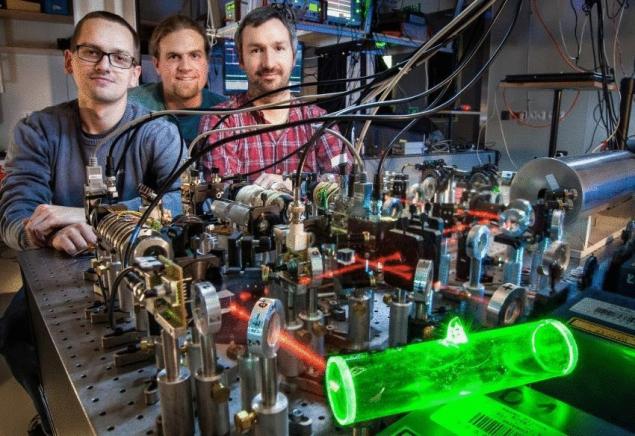Global quantum communication can be closer than you think
 Bashny.Net
Bashny.Net

Neither quantum computers nor quantum cryptography will not be able to obtain an adequate development and become prevalent technologies without memory systems able to manipulate quantum information easily and effectively. The faculty of physics of University of Warsaw is trying to popularize quantum information technologies by creating an atomic memory with incredible features and an extremely simple design.
After several years of tests in physics laboratories, the first quantum technologies are slowly but surely gaining traction. One example is quantum cryptography — an encryption method that provides almost full guarantee of secure data transmission and is currently being adopted by the armed forces and banking institutions. Processing quantum information and sending it long distance, however, is severely limited by lack of memory. Writes Phys.org the University of Warsaw in Poland created a fully-functioning atomic memory with a simple and reliable design, which can be used in several applications, including telecommunications.
"The biggest challenge in the creation of our quantum memory was the precise selection of system parameters that would allow it to effectively save, store and read quantum information. We have also found a way to reduce the noise during the search and discovery [of information]" — said the scientist Wojciech Wasilewski.
Modern optical networks include the transmission of classical information using laser light propagated inside the fiber optic cables. However, the attenuation of light signals in this fiber leads to the fact that it is attenuated when passing long distances. The use of fiber optic cables for every 100 kilometers you have to place laser amplifiers, multiplying photons. They turn a weak signal with a small number of photons into a strong signal with a large number of photons.
However, in quantum communications important individual photons and their quantum States. In this area, the signal enhancement means not only multiplies the number of photons, but rather preserving their original intact quantum States. Unfortunately, quantum information cannot be duplicated with impunity: holding any measurement of a quantum state of the photon will inevitably affect its original condition. The impossibility of quantum cloning, it is open to the Polish physicist by Wojciech Zurek, imposes fundamental limitations on the operations that can be done with quantum information.
In 2001, a group of physicists from the University of Innsbruck and Harvard University proposed the Protocol of DLCZ quantum transmission, thereby making possible the transmission of quantum information over long distances. According to this Protocol, the quantum information that falls into each relay node in the network will be stored there long enough to guarantee the successful transmission to the next node. But in this Protocol the key role played by quantum memory to store quantum information for a long time.
"Until now, quantum memory required sophisticated laboratory equipment and complex techniques chilling the systems to extremely low temperatures close to absolute zero. The atomic memory device we have created can operate at much higher temperatures, in the range of 10 degrees Celsius, and this memory is much easier to maintain," notes Radek Rapkiewicz, graduate student and co-author of the work.
The basic element of the memory device, created by physicists at the University of Warsaw, is a glass chamber 2.5 cm in diameter and 10 cm in length, the sides of which are covered by rubidium, and she is filled with an inert gas. When the tube is slowly heated, rubidium pairs fill the chamber, while the inert gas slows down their movement and thus reduces the noise. When quantum information is stored in the cell, the photons of the laser beam "imprint" of the quantum state on the set of rubidium atoms. At the same time and other emitted photons, and their detection suggests that the information was saved. The information stored in memory can be fetched using another specially designed laser pulse.
To record and retrieve quantum information, the researchers used advanced methods of light filtering and an innovative camera of his own design. This camera is able to distinguish individual photons is extremely low noise and the speed is ten times higher than existing cameras.
"Stability of quantum information stored in the memory lasts from a few microseconds to tens of microseconds. You can ask the question, how does such short-lived memory could be useful, but keep in mind that it all depends on the application. In telecommunications, the time frame in microseconds are sufficient to make several attempts to transmit a quantum signal to the next relay station," stresses Michael Dabrowski, PhD student of the faculty.
Experienced working with subtle quantum optics phenomena has allowed scientists at Warsaw University to significantly reduce the noise level in the quantum signals. In data mining a large part of the noise is carried away by photons that are emitted from the memory cells, in another direction different from the one in which leaves the quantum information.
The same cell atomic quantum memory can store the light with different types of spatial modes (types of vibration). From this it follows that achievements of scientists are most available capacity at the moment. In real quantum telecommunications application one cell of this new type can serve as a buffer memory for several fiber optic cables simultaneously.
Source: hi-news.ru
Tags
See also
Simpsion: the Soul can be mistress and slave
Amazing ability of animals
18 ways not to be discouraged when it seems that can not be worse
Julian Assange: Google is not what it seems from the sandbox (part 3)
Global Wi-Fi is closer than you think
Quantum information transfer will be more reliable
Julian Assange: Google is not what it seems from the sandbox. Part 4
Svetlana roiz: Ideal school does not exist!

















